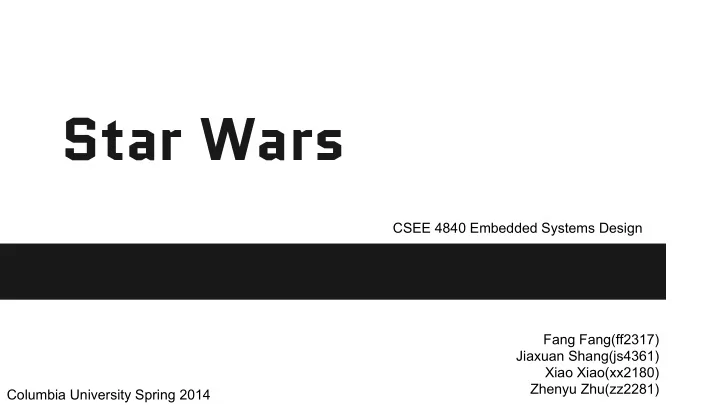

Star Wars CSEE 4840 Embedded Systems Design Fang Fang(ff2317) Jiaxuan Shang(js4361) Xiao Xiao(xx2180) Zhenyu Zhu(zz2281) Columbia University Spring 2014
Overview of the project ● Inspired by the classic game Geometry Wars ○ Various enemy flying round or chasing after the spaceship. ○ Player’s goal is to survive as long as possible and get a score as high as possible with 3 lives. ○ Bomb available to destroy all the enemies at once ● Overall 60 entities, first entity saved for spaceship, 2nd to 30th for bullets, and last 30 for enemies. ○ ID number indicating entity type ○ X, Y coordinates and direction information also contained in each unit data
Architecture
VGA_BALL ● Module: VGA_BALL ● submodule: VGA_BALL_Emulator
VGA_BALL ● Receives 10-bit writedata in a total of 256 (2- reg structure) ● Combines every four of them to form the information for every object (in a total of 64): [31:0] logic data_to_emulator: [id, x, y, direction] ● Connects to the submodule VGA_BALL_Emulator to draw the graph
Flow Chart (Processing state)
VGA_BALL ● Receives data from the software: 2-reg structure One for transmission One for updating reg [9:0] data1 [0:255]; reg [9:0] data2 [0:255];
VGA_BALL_Emulator ● Receives 32-bit object information and stores into 2 RAMs: One for updating, one for transmission. ● Stores the RGB value of every object into the line buffer (3 RAMs: one for updating, one for drawing, one for cleaning) according to the object information. ● Read the rom and draw the objects according to the RGB value
VGA_BALL_Emulator Flow chart of Line Buffers
Audio Implementation ● I2C protocol: data is sent a bit at a time over the SDAT wire, with the separation between bits determined by clock cycles on the SCLK wire. ● I2C is a master-slave protocol. In our project, the FPGA is the master and the audio codec is the slave. ● Audio components: ○ I2C controller: control the transmission timing, configuration interface. ○ Configuration controller: determines what data to send--16-bit words. Use 19 9- bit regs to record configurations, the first 7 bits are the reg address and the last 9 bits are the register contents. Reference: Exploring the Arrow SoCKit Part - The Audio Codec
Audio Implementation contd. ● Audio components (contd.): ○ Clocks: use Cyclone V’s Phase-Locked Loops to generate master clock for audio codec. Other bit clock and LRC are generated using frequency divider. ○ Audio codec driver: the data is pushed out or read in through shift registers. ● Audio output: ○ Receive flag information from software. Control production of sound. ○ The .wav file is converted into .mif and the data is stored in ROMs. Reference: Exploring the Arrow SoCKit Part - The Audio Codec
Software and algorithms ● Overall game logic control ○ bomb detection ○ bullet generation ○ enemy generation ○ collision detection ○ units movement control ○ score, life, bomb data collection ● Sending array messages of 256 elements to hardware containing information of 60 entities and player data information (scores, lifes, bombs, etc.)
Flow Chart (Software)
Experiences and Issues ● Game logic moved from hardware to software. ● Improved logic usage (34% to 17%) on the board. ● Better VGA display using sprite scheme. ● Treat the reg/ram as memory and ensure only to read/write one value from/into the memory at one clock cycle. ● After writing into the memory, the data could only be read out two cycles later. Thus the state for stabilize the data is needed.
Experiences and Issues ● Overlap: Solution 1: Change the C code to avoid overlap (not good) Solution 2: Use the line buffers to store the 32-bit information about the objects for each pixel (cannot solve this problem) Solution 3: Use the line buffers to store the RGB value (currently use)
Recommend
More recommend